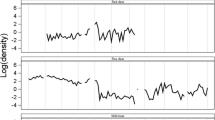Abstract
The common dormouse (Muscardinus avellanarius) is a species included in Annex IV of the Habitat Directive and red-listed in many European countries. Monitoring of M. avellanarius is implemented in several countries using different methods. In Lithuania, regular control of standard bird nestboxes and marking of all dormice caught were used during 1984–1990 and 1999–2007. Nestboxes were spaced in a grid system at 50 m intervals in an area of 60 ha. Monitoring of the M. avellanarius population was carried out in a managed forest with varying levels of human activity occurring in most parts of the forest (felling of all understorey, selective felling of trees, clear felling, etc.). During the entire study period, the average density of the population was comparatively low (about 1 ind./ha in spring and 3 ind./ha in autumn), but stable and without substantial fluctuations in spite of considerable human activity. The forestry management operations that were used in different parts of the forest over different years had only temporary and localised negative effects on the abundance of M. avellanarius, and did not influence the whole population substantially. The spacing of nestboxes in a grid system in a large forest area increased the level of accuracy with which the monitoring scheme reflected the population status. This enabled both the state of the entire population of M. avellanarius and temporary changes in abundance in selected smaller plots to be tracked.

Similar content being viewed by others
References
Berg L (1996) Small-scale changes in the distribution of the dormouse Muscardinus avellanarius (Rodentia, Myoxidae) in relation to vegetation changes. Mammalia 60:211–216
Bright PW (1995) Distribution of the dormouse Muscardinus avellanarius in Wales, on the edge of its range. Mamm Rev 25:101–110. doi:10.1111/j.1365-2907.1995.tb00449.x
Bright PW, Morris PA (1990) Habitat requirements of dormice Muscardinus avellanarius in relation to woodland management in Southwest England. Biol Conserv 54:307–326. doi:10.1016/0006-3207(90)90143-D
Bright PW, Morris PA (1996) Why are dormice rare? A case study in conservation biology. Mamm Rev 26:157–187. doi:10.1111/j.1365-2907.1996.tb00151.x
Bright P, Morris P, Mitchell-Jones T (2006) The dormouse conservation handbook, 2nd edn. English Nature, Peterborough
Capizzi D, Battistini M, Amori G (2002) Analysis of the hazel dormouse, Muscardinus avellanarius, distribution in a Mediterranean fragmented woodland. Ital J Zool (Modena) 69:25–31
Caughley G (1977) Analysis of vertebrate populations. Wiley, London
Eden SM, Eden RMG (2001) The dormouse in Dorset: a reappraisal of dormouse ecology. Dorset Proc 123:75–94
EuMon database (2008) http://eumon.ckff.si/monitoring/. Accessed 29 Jun 2008
Flowerdew JR (1976) Ecological methods. Mamm Rev 6:123–159. doi:10.1111/j.1365-2907.1976.tb00208.x
Foppen R, Verheggen L, Boonman M (2002) Biology, status and conservation of the hazel dormouse (Muscardinus avellanarius) in the Netherlands. Lutra 45:147–154
Juškaitis R (2001) Weight changes of the common dormouse (Muscardinus avellanarius L.) during the year in Lithuania. Trak Univ J Sci Res Ser B 2:79–83
Juškaitis R (2002) Spatial distribution of the yellow-necked mouse (Apodemus flavicollis) in large forest areas and its relation with seed crop of forest trees. Mamm Biol 67:206–211. doi:10.1078/1616-5047-00031
Juškaitis R (2003) Abundance dynamics and reproduction success in the common dormouse, Muscardinus avellanarius, populations in Lithuania. Folia Zool (Brno) 52:239–248
Juškaitis R (2005) The influence of high nestbox density on the common dormouse Muscardinus avellanarius population. Acta Theriol (Warsz) 50:43–50
Juškaitis R (2006) Nestbox grids in population studies of the common dormouse (Muscardinus avellanarius L.): methodological aspects. Pol J Ecol 54:351–358
Juškaitis R (2007a) Habitat selection in the common dormouse (Muscardinus avellanarius) in Lithuania. Balt For 13:89–95
Juškaitis R (2007b) Feeding by the common dormouse (Muscardinus avellanarius): a review. Acta Zool Litu 17:151–159
Juškaitis R (2007c) Peculiarities of habitats of the common dormouse, Muscardinus avellanarius, within its distributional range and in Lithuania: a review. Folia Zool (Brno) 56:337–348
Juškaitis R, Remeisis R (2007) Summer nest sites of the common dormouse Muscardinus avellanarius L. in young woodlands of Lithuania. Pol J Ecol 55:795–803
Krebs ChJ (1999) Ecological methodology, 2nd edn. Addison Wesley Longman, Menlo Park
StatSoft (2001) STATISTICA (data analysis software system), version 6. www.statsoft.com. Accessed 27 Sep 2007
Verbeylen G (2006) Status and conservation of the common dormouse (Muscardinus avellanarius) in the province of Limburg (Flanders, Belgium). Lutra 49:75–88
Vilhelmsen H (2003) Status of dormice (Muscardinus avellanarius) in Denmark. Acta Zool Hung 49(Suppl 1):139–145
Acknowledgements
This paper is a result of the EuMon project (http://eumon.ckff.si), funded by the European Commission (contract number 6463). An anonymous reviewer made valuable comments on earlier versions of the manuscript, and David Price revised the English. Forestry officer Jonas Gvildys supported dormouse monitoring in the Gelgaudiškis forestry district during all the study period.
Author information
Authors and Affiliations
Corresponding author
Electronic supplementary material
Below is the link to the electronic supplementary material.
Fig. S1
Scheme of the study site (area 60 ha) where monitoring of M. avellanarius population was carried out in Lithuania during 1984–1990 and 1999–2007. Plots with different forest management activities are grey-shaded: 1) plot UF-99 (area ~12 ha)—all hazel dominated understorey was felled in 1999; 2) plot UF-00 (area ~8 ha)—all hazel dominated understorey was felled in 2000; 3) plot CF-02 (area ~2.5 ha)—clear felled in winter 2001/2002, leaving only young spruce trees. Foresters planted additional young spruce and oak trees in 2004 and thinned the re-growth in 2007; 4) plot T-04 (area ~5 ha)—clear-felled in 1991, thinning of re-growth in 1997 and 2004. A young birch dominated stand was consequently formed; 5) plot SF-04 (area ~5 ha)—selective felling of mature trees and some hazels in autumn 2004. To assist removal of timber, clear-felled belts were formed every 20 m. 1—nestbox, 2—forest edge, 3—forest road (EPS 4649 kb)
Rights and permissions
About this article
Cite this article
Juškaitis, R. Long-term common dormouse monitoring: effects of forest management on abundance. Biodivers Conserv 17, 3559–3565 (2008). https://doi.org/10.1007/s10531-008-9470-9
Received:
Accepted:
Published:
Issue Date:
DOI: https://doi.org/10.1007/s10531-008-9470-9




